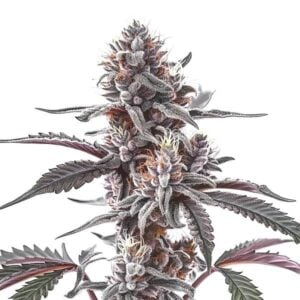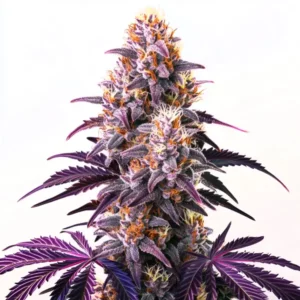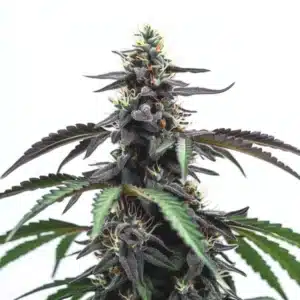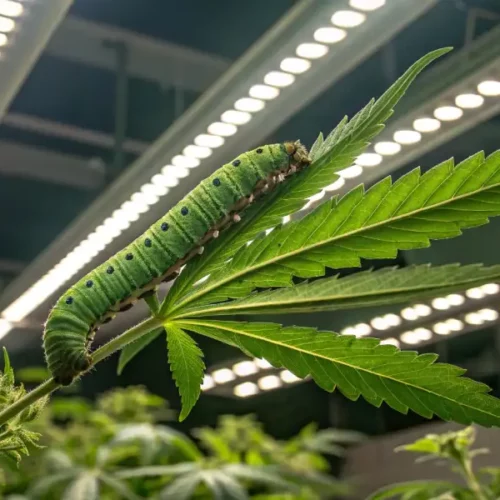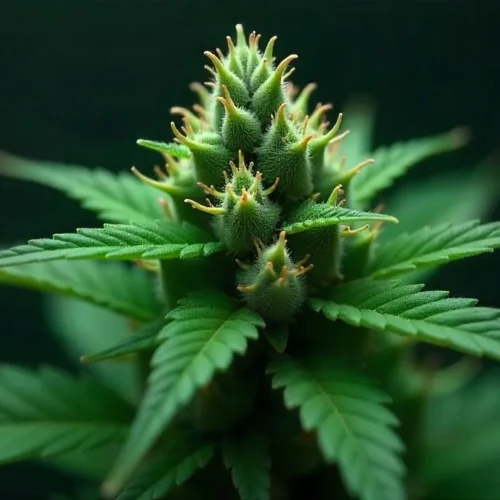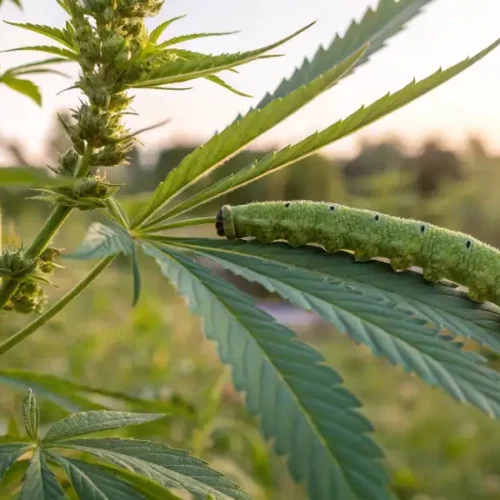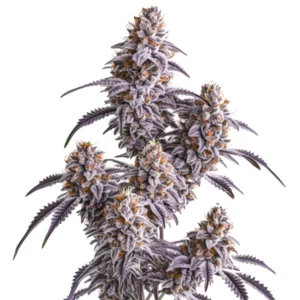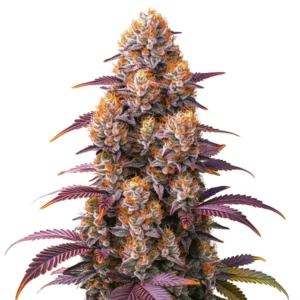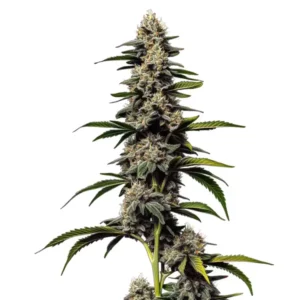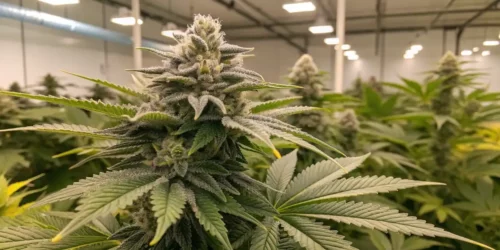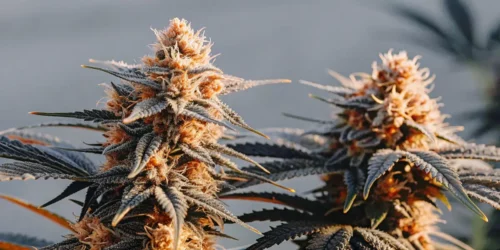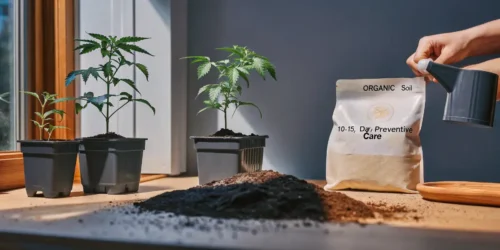Managing humidity during the flowering stage is essential to producing high-quality cannabis buds and avoiding mold or mildew. The right humidity levels can enhance resin production, encourage healthy bud development, and prevent harmful moisture buildup. In this article, we’ll explore the best humidity for flower stage, how to manage it effectively, and the potential problems that arise when humidity is too high or too low.
Knowing Humidity’s Function in the Flowering Stage
Humidity plays a important function in every stage of cannabis growth, but it becomes especially important during the flowering stage. As the plant transitions from vegetative growth to producing buds, controlling moisture levels can make or break your final yield.
Recommended Strains
Fat Bastard
 THC: 30% - 38%
THC: 30% - 38% Type of seed: Feminized
Type of seed: Feminized Phenotype: Mostly Hybrid
Phenotype: Mostly Hybrid Day to flower: 8 - 10 weeks
Day to flower: 8 - 10 weeks
Fat Bastard Auto
 THC: 30% - 38%
THC: 30% - 38% Type of seed: Autoflowering
Type of seed: Autoflowering Phenotype: Mostly Hybrid
Phenotype: Mostly Hybrid Day to flower: 8 - 10 weeks
Day to flower: 8 - 10 weeks
Why Humidity Levels Matter for Cannabis Flowering
During the flowering stage, the plant’s energy is focused on producing dense buds. These buds are sensitive to excess moisture, which can lead to a host of problems, from poor resin production to the development of mold and mildew. Maintaining this levels ensures that the buds develop in a dry, controlled environment where moisture doesn’t get trapped, allowing for optimal growth and potency.
High humidity levels can cause water to accumulate within the buds, which promotes fungal growth and compromises the overall quality. On the other hand, too little humidity can dry out the plants, leading to less efficient nutrient uptake, and eventually affecting the plant’s health.
The Impact of Humidity on Bud Development and Resin Production
When cannabis plants are exposed to the right humidity during flowering, the buds develop more resin, leading to higher cannabinoid and terpene levels. This results in more potent and flavorful flowers, making humidity control a key factor in achieving top-quality cannabis. The best humidity for flower stage helps in balancing moisture levels to promote trichome production without risking bud rot or mold.
Too much moisture in the air can block the natural production of resin, leaving your buds with fewer trichomes and reduced potency. Maintaining ideal humidity levels throughout the flowering stage is essential for a successful harvest.
How High Humidity Can Lead to Mold and Mildew in Cannabis Flowers
One of the biggest threats to flowering cannabis is high humidity. When humidity levels rise above 60%, the risk of mold and mildew significantly increases. Mold can form deep within the dense buds where airflow is limited, causing devastating damage to your plants and rendering your buds unusable.
Powdery mildew and bud rot are common fungal problems in high-humidity environments. By maintaining this levels, you can prevent these issues, ensuring that your buds remain healthy, potent, and mold-free.
Promos & Deals
Best Humidity Range for Flowering Cannabis
Finding the right balance of humidity during the flowering stage is important for maintaining healthy growth and avoiding moisture-related problems. The ideal humidity range shifts depending on whether you’re in the early or late stages of flowering.
Ideal Humidity Levels During Early Flowering Stage
In the early stages of flowering, when the buds are still developing, keeping the humidity between 45% and 55% is ideal. This level of humidity allows for sufficient moisture retention without risking mold. During this phase, the plant is still taking up a lot of water and nutrients, so maintaining moderate humidity helps facilitate nutrient uptake.
The best humidity for flower stage during this period promotes vigorous bud growth without exposing the plants to excess moisture. Ensuring good airflow and ventilation helps to regulate humidity while keeping the environment stable for the plants.
Adjusting Humidity During Late Flowering to Prevent Mold
As you approach the later stages of flowering, particularly in the final two weeks, it’s essential to reduce humidity levels to around 40-45%. Lowering humidity at this stage helps dry out the buds slightly, reducing the chances of mold forming in the dense flowers. It also encourages resin production as the plant begins to prepare for harvest.
Lowering humidity in the late flower stage also helps speed up the drying process post-harvest, resulting in better curing conditions. The best humidity for flower stage during this phase ensures that the buds reach their full potential in both potency and flavor while preventing any moisture-related issues.
Balancing Humidity and Temperature for Optimal Flower Growth
Humidity and temperature go hand-in-hand when it comes to cannabis cultivation. Maintaining the right temperature during the flowering stage is just as important as controlling humidity. Ideally, the temperature should be kept between 70°F and 80°F (21°C to 26°C) during the light cycle, with a slight drop during the dark cycle.
By keeping the temperature and humidity levels balanced, you can create an environment where the plants are neither stressed by heat nor overwhelmed by moisture. Achieving this levels also involves ensuring your temperature settings are optimal, as high temperatures combined with high humidity can lead to major problems like heat stress and mold growth.
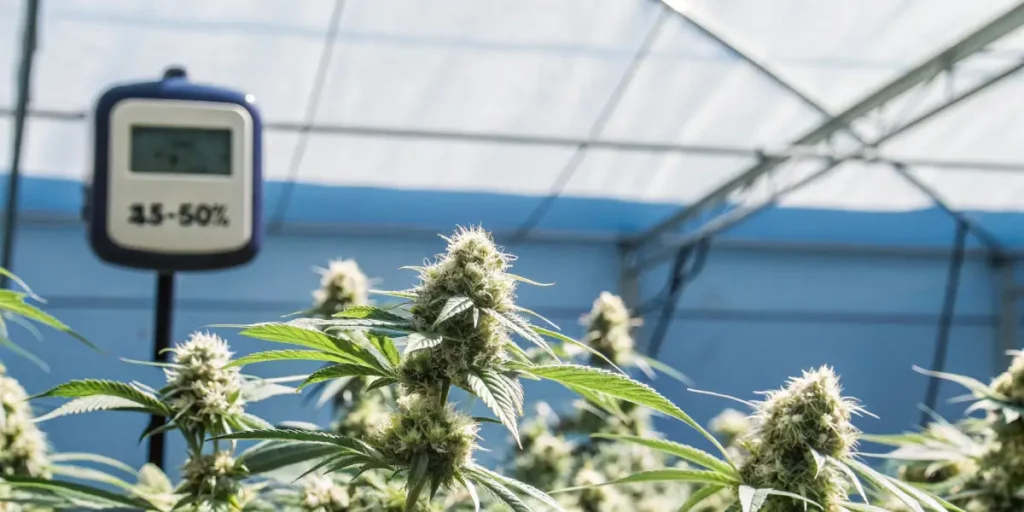
How to Control Humidity in Your Grow Room During Flowering
Controlling humidity levels during the flowering stage is essential for the health and quality of your cannabis buds. Whether you’re growing indoors or in a greenhouse, maintaining this levels requires the right equipment and strategies to create an optimal environment.
Using Dehumidifiers to Keep Humidity in Check
Dehumidifiers are one of the most effective tools for managing humidity in your grow room, especially during the flowering stage. A good dehumidifier can pull excess moisture from the air, preventing the buildup of humidity that can lead to mold and mildew. This is particularly important in the later stages of flowering when the buds are dense and more susceptible to moisture-related issues.
When selecting a dehumidifier for your grow space, choose one that matches the size of the room. Larger grow areas will require more powerful dehumidifiers, while smaller grow tents may only need compact units. Adjusting the settings based on the current humidity levels allows you to maintain the best humidity for flower stage, ensuring your plants remain in the optimal range.
Improving Airflow and Ventilation to Manage Humidity
Proper airflow and ventilation are key to preventing humidity from building up around your plants. Stagnant air creates pockets of high humidity, especially around dense buds, which can lead to mold. By improving airflow in your grow room, you can maintain even humidity levels and reduce the risk of moisture-related problems.
Fans are an essential part of any indoor grow setup. Use oscillating fans to keep air circulating around the plants, ensuring that no areas become overly humid. Ventilation systems that pull in fresh air and exhaust humid air can also help regulate moisture levels. By pairing good airflow with the right ventilation system, you can maintain this levels, allowing your buds to develop in a healthy, mold-free environment.
Monitoring Humidity with Hygrometers for Accuracy
Accurate humidity control starts with precise monitoring. Hygrometers are essential tools for tracking the humidity levels in your grow room. These devices measure the amount of moisture in the air and provide real-time data so you can make adjustments as needed.
Place hygrometers at various points in your grow room to get a comprehensive understanding of the humidity levels. Monitoring both the upper canopy and lower plant areas will help you spot any humidity fluctuations that could affect your plants. By using multiple hygrometers, you can ensure that the best humidity for flower stage is maintained throughout the entire grow space.
Common Humidity-Related Problems in the Flowering Stage
Even with the best efforts to control humidity, issues can still arise during the flowering stage. Being able to identify and address these problems early is important to saving your plants and ensuring a healthy harvest.
Recognizing Signs of High Humidity in Cannabis Buds
High humidity levels can cause several visible symptoms in your cannabis plants, particularly in the buds. One of the first signs is the development of moisture inside the buds, which can lead to a soft, mushy texture. If you notice any condensation on the leaves or buds, it’s a clear sign that the humidity is too high.
In some cases, high humidity can also cause the leaves to turn yellow or brown as the plant struggles to cope with the excess moisture. Regularly checking your buds and leaves for signs of high humidity is essential for maintaining this levels and avoiding more serious problems like mold or mildew.
Preventing Bud Rot and Powdery Mildew in High Humidity
Bud rot (botrytis) and powdery mildew are two of the most common issues caused by high humidity during the flowering stage. Bud rot starts from the inside of the buds, making it difficult to detect until it’s too late. By the time it’s visible, much of the bud may already be destroyed.
Powdery mildew, on the other hand, appears as a white, powdery substance on the leaves and buds. It thrives in humid environments with poor airflow and can quickly spread throughout your plants if not addressed.
The best humidity for flower stage is one that keeps moisture levels low enough to prevent these issues. Regular pruning, ensuring proper airflow, and keeping humidity below 50% during the flowering stage can help prevent bud rot and powdery mildew from taking hold.
How to Recover from Humidity-Related Issues During Flowering
If you notice signs of bud rot or powdery mildew, acting quickly can save your harvest. Start by removing any affected buds or leaves, being careful not to spread spores to other parts of the plant. Lowering the humidity and increasing airflow in your grow room are also important steps in halting the spread of these diseases.
If powdery mildew is present, consider using an organic fungicide or a sulfur spray to eliminate it. For bud rot, prevention is key, as once the rot takes hold, there’s little that can be done to reverse the damage. Maintaining this levels through constant monitoring and adjustment will minimize the risk of these issues.
Tips for Maintaining Ideal Humidity for Flowering Cannabis
Maintaining the ideal humidity for flowering cannabis is a balance of using the right tools and staying vigilant throughout the growing process. Here are some tips to ensure your grow room stays within the optimal humidity range, keeping your plants healthy and productive.
Humidity Control Strategies for Indoor Grows
Indoor grows allow you to have complete control over the environment, making it easier to maintain this levels. In addition to using dehumidifiers and fans, consider implementing a full HVAC (heating, ventilation, and air conditioning) system that can regulate both temperature and humidity.
For smaller grow setups, portable air conditioners or heaters can help manage temperature and, by extension, humidity. Keeping your grow room sealed will prevent external humidity from entering, while using proper insulation can help maintain stable internal conditions.
Adjusting Humidity Based on Grow Room Size and Conditions
The size of your grow room will affect how you control humidity. Smaller grow tents tend to trap heat and moisture more easily, requiring smaller, more frequent adjustments. In contrast, larger grow rooms may need industrial-sized dehumidifiers or ventilation systems to maintain optimal conditions.
No matter the size of your grow space, the best humidity for flower stage will be achieved by ensuring consistent airflow, regularly checking humidity levels, and making adjustments based on the needs of your plants.
Ensuring Consistent Humidity Levels for Better Bud Quality
Consistency is key when it comes to managing humidity in the flowering stage. Sudden fluctuations in humidity can stress the plants and affect bud development. Aim to keep humidity levels within the recommended range at all times, even during the dark cycle when plants are more susceptible to moisture buildup.
By maintaining the best humidity for flower stage, you not only protect your plants from disease but also encourage better bud growth, higher resin production, and a more flavorful harvest. Consistent humidity management is the foundation for producing top-quality cannabis flowers.
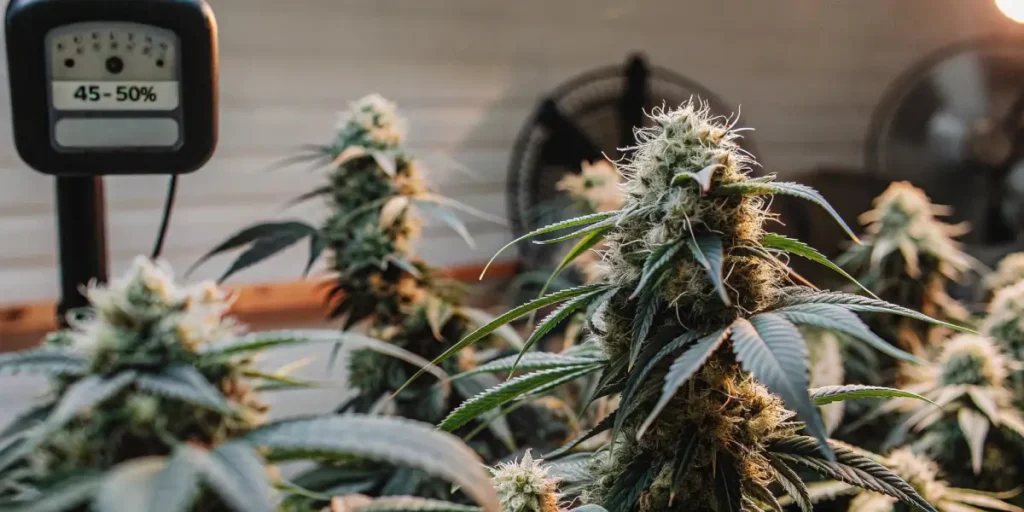
Balancing Humidity with Other Environmental Factors During Flowering
Maintaining the best humidity for flower stage goes beyond just managing moisture levels. It’s also essential to consider how humidity interacts with other environmental factors, such as temperature, light, and airflow. Getting these factors right will create an optimal environment for your cannabis plants to thrive, especially during the critical flowering phase.
Temperature and Humidity: Finding the Perfect Balance
Temperature and humidity are closely linked. As the temperature rises, the air can hold more moisture, which can increase the humidity levels in your grow room. For flowering cannabis, keeping the temperature between 70°F and 80°F during the light cycle is ideal. This range allows your plants to grow without stress while preventing excess moisture from building up.
During the dark cycle, lowering the temperature slightly (around 65°F to 70°F) helps to simulate natural outdoor conditions and keeps humidity in check. If the temperature gets too high, it can cause your humidity levels to spike, leading to a greater risk of mold. The best humidity for flower stage is maintained when both temperature and moisture levels are properly balanced.
How Light and Humidity Interact During Flowering
Light also plays a function in regulating humidity. When grow lights are on, they generate heat, which can dry out the air and lower humidity. While this might seem beneficial for controlling moisture, it can lead to overly dry conditions if not monitored carefully. In contrast, when the lights are off during the dark cycle, humidity levels tend to rise because the temperature drops, and there’s less evaporation.
To prevent these fluctuations, it’s essential to monitor both humidity and temperature closely during light and dark cycles. Using timers and automated systems to control dehumidifiers, fans, and heaters can help maintain consistent conditions. By keeping the environment stable, you can ensure that the best humidity for flower stage is achieved, even as your lights cycle on and off.
The Importance of CO2 and Humidity Control
Some advanced cannabis growers use CO2 (carbon dioxide) enrichment to boost plant growth during the flowering stage. While CO2 can significantly increase yields, it also requires careful management of humidity and temperature. High CO2 levels enable plants to handle slightly higher temperatures, but if the humidity is too high, it can still lead to problems like bud rot.
When using CO2, aim to keep the humidity around 45% during the flowering stage to prevent moisture buildup. The added CO2 will allow your plants to handle slightly warmer temperatures without increasing the risk of mold or mildew. Ensuring the best humidity for flower stage while using CO2 can result in larger, denser buds without sacrificing quality.
Humidity Management for Different Growing Setups
The type of growing setup you use whether it’s indoor, outdoor, or greenhouse will determine how you approach humidity control. Each environment presents its own challenges, but maintaining this levels for flower stage is key to ensuring healthy bud development and preventing moisture-related issues.
Indoor Growing: Precision Humidity Control
Indoor cannabis grows offer the most control over the environment, making it easier to maintain this levels. With the help of dehumidifiers, fans, and air conditioning systems, indoor growers can create an optimal climate for their plants, regardless of external weather conditions.
In an indoor setup, it’s important to monitor humidity constantly, as sealed grow rooms can trap moisture quickly. Using automated systems that adjust humidity levels based on real-time readings can help prevent spikes or drops in moisture, ensuring a stable environment for flowering cannabis.
Greenhouse Growing: Managing Humidity with Natural Elements
Greenhouse growing combines elements of both indoor and outdoor cultivation, offering natural light while providing some protection from the elements. However, humidity control in a greenhouse can be more challenging, as the structure can trap heat and moisture, especially during hot days.
To maintain this levels in a greenhouse, consider using vents, fans, and shading to regulate temperature and airflow. Opening vents during the day allows moisture to escape, while fans help keep the air circulating. In some cases, using a small dehumidifier inside the greenhouse can help manage excess humidity during the flowering stage.
Outdoor Growing: Dealing with Natural Humidity
For outdoor growers, controlling humidity can be more difficult, as you’re subject to natural weather patterns. In humid climates, outdoor cannabis plants are at a higher risk for mold and mildew, particularly during the flowering stage. While you can’t control the weather, there are steps you can take to reduce humidity-related problems.
One effective strategy is to plant cannabis in areas with good natural airflow. Avoid dense foliage or low-lying areas where moisture can accumulate. Additionally, spacing plants farther apart can improve air circulation, reducing the chances of moisture getting trapped within the buds.
If you live in an area with frequent rain during the flowering stage, consider using protective covers or building a temporary shelter to shield your plants from excess moisture. While it’s more challenging to manage humidity outdoors, taking these steps can help you maintain this levels and protect your buds from mold.
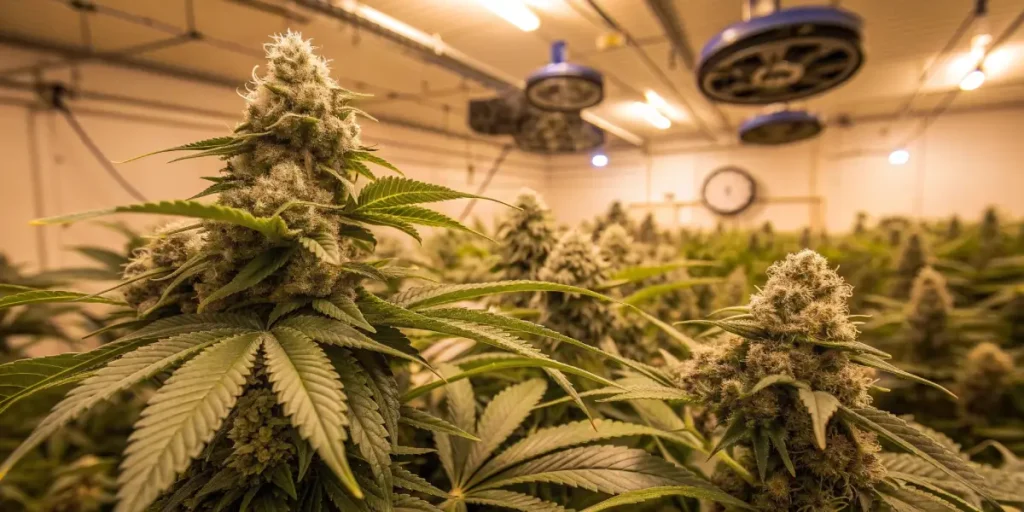
Long-Term Benefits of Maintaining Ideal Humidity in Flowering
Keeping your humidity levels in check throughout the flowering stage not only helps prevent immediate issues like mold and mildew but also has long-term benefits for the quality and potency of your cannabis.
Better Resin Production and Potency
When humidity is properly controlled during the flowering stage, plants focus more energy on resin production. Resin contains the cannabinoids and terpenes that give cannabis its potency and aroma, so optimizing humidity ensures that your buds are rich in these compounds. The best humidity for flower stage promotes higher trichome production, leading to more potent flowers with greater medicinal and recreational value.
Improved Flavor and Aroma
spray Terpenes, the compounds responsible for the flavor and aroma of cannabis, are sensitive to environmental conditions. High humidity can degrade terpene levels, leading to buds that are less flavorful and aromatic. By maintaining the ideal humidity levels during flowering, you can preserve the integrity of the terpenes, resulting in cannabis that is more fragrant and flavorful.
Reduced Risk of Disease and Pests
Consistent humidity control also helps protect your plants from diseases and pests. Fungal infections like powdery mildew thrive in high-humidity environments, while pests such as spider mites prefer dry conditions. By keeping the humidity within the recommended range, you create an environment where your plants are less vulnerable to these threats.
FAQs
What is the best humidity for cannabis during the flowering stage?
The ideal humidity for cannabis during the flowering stage is between 45% and 55% in early flowering, and around 40% to 45% in late flowering. Maintaining these levels helps prevent mold and mildew while encouraging resin and trichome production for potent, flavorful buds.
How does high humidity affect cannabis buds in flower?
High humidity during the flowering stage increases the risk of mold, mildew, and bud rot, especially in dense flowers where airflow is limited. It can also reduce resin production and compromise the potency and quality of your cannabis harvest.
What are effective ways to control humidity during flowering?
To control humidity, use dehumidifiers, ensure proper airflow with oscillating fans, and monitor levels with hygrometers. In late flowering, lowering humidity below 45% is crucial to prevent moisture-related issues and preserve bud quality.




